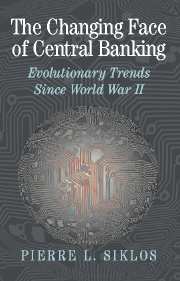Book contents
- Frontmatter
- Contents
- List of Figures
- List of Tables
- Preface
- 1 The Institutional Make-Up and Evolution of Central Bank–Government Relations: An Introduction
- 2 Legislation Alone Does Not a Central Bank Make: Political Structure, Governance, and Reputation in Monetary Policy
- 3 Central Bank Personalities and Monetary Policy Performance
- 4 Econometric Analysis of Central Bank Behavior: An Evolutionary Approach
- 5 Contrasting Quantitative and Qualitative Assessments of Central Bank Behavior and the Evolution of Monetary Policies
- 6 Accountability, Disclosure, and Conflict Resolution
- 7 Inflation Targets versus Other Inflation Control Measures: Two Sides of the Same Coin?
- 8 The Changing Face of Central Banking: Epilogue
- Bibliography
- Index
- Titles in the series
4 - Econometric Analysis of Central Bank Behavior: An Evolutionary Approach
Published online by Cambridge University Press: 27 October 2009
- Frontmatter
- Contents
- List of Figures
- List of Tables
- Preface
- 1 The Institutional Make-Up and Evolution of Central Bank–Government Relations: An Introduction
- 2 Legislation Alone Does Not a Central Bank Make: Political Structure, Governance, and Reputation in Monetary Policy
- 3 Central Bank Personalities and Monetary Policy Performance
- 4 Econometric Analysis of Central Bank Behavior: An Evolutionary Approach
- 5 Contrasting Quantitative and Qualitative Assessments of Central Bank Behavior and the Evolution of Monetary Policies
- 6 Accountability, Disclosure, and Conflict Resolution
- 7 Inflation Targets versus Other Inflation Control Measures: Two Sides of the Same Coin?
- 8 The Changing Face of Central Banking: Epilogue
- Bibliography
- Index
- Titles in the series
Summary
INTRODUCTION
The quantitative study of central bank behavior has a long history. Introduced in the heyday of trust in fine tuning, functions describing how central banks react to economic conditions, called reaction functions, were intended to convey the belief that a central bank or government could achieve a set of economic goals by solving an optimal control problem. Political or institutional considerations did not matter initially since policy makers were assumed to have the requisite instruments at hand to optimally achieve desired objectives.
Until recently, and other than general dissatisfaction with the concept of fine tuning born out of the stagflation of the 1970s, two other rather technical issues led economists to shy away from estimating reaction functions for a time. These were the temporal instability of estimates and the inability of standard functions to reveal policy makers' preferences. By contrast, political scientists never lost their enthusiasm for the approach as their concerns primarily dealt with political influences on the macroeconomy in general. The ability to separately identify the preferences of the central bank or government from those of the public was considered secondary, perhaps because the State and the central bank were not viewed as separate institutions as such.
Recently, reaction functions have been interpreted, as we shall see, as a device to reflect rules like behavior apparently adopted by several central banks. Some of the earlier technical problems remained but economists overcame, to some extent, their displeasure with the reaction function approach thanks in part to several important developments the econometric analysis of time series.
- Type
- Chapter
- Information
- The Changing Face of Central BankingEvolutionary Trends since World War II, pp. 128 - 192Publisher: Cambridge University PressPrint publication year: 2002



